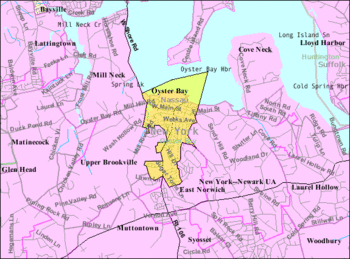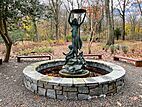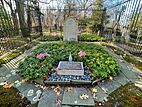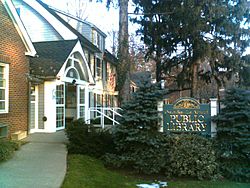Oyster Bay (hamlet), New York facts for kids
Quick facts for kids
Oyster Bay, New York
|
|
|---|---|
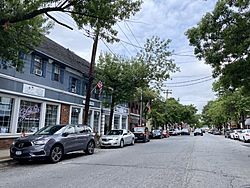
Downtown Oyster Bay, 2021
|
|
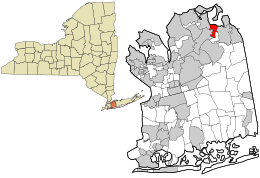
Location in Nassau County and the state of New York.
|
|
| Country | |
| State | |
| County | |
| Town | Oyster Bay |
| Area | |
| • Total | 1.61 sq mi (4.16 km2) |
| • Land | 1.24 sq mi (3.20 km2) |
| • Water | 0.37 sq mi (0.96 km2) |
| Elevation | 180 ft (55 m) |
| Population
(2020)
|
|
| • Total | 7,049 |
| • Density | 5,698.46/sq mi (2,200.23/km2) |
| Time zone | UTC-5 (Eastern (EST)) |
| • Summer (DST) | UTC-4 (EDT) |
| ZIP code |
11771
|
| Area code(s) | 516 |
| FIPS code | 36-55992 |
Oyster Bay is a small community located on the North Shore of Long Island in Nassau County, New York. It's known as a hamlet and a census-designated place (CDP). This means it's a recognized community that isn't officially a village or town. Oyster Bay is also home to a train station, which is the last stop on the Long Island Rail Road's Oyster Bay line.
The area of Oyster Bay used to be much larger. Over time, some parts became their own separate villages, like Mill Neck, Bayville, and Centre Island. Even today, the Oyster Bay Post Office serves several nearby villages. In 2020, about 7,049 people lived in the CDP of Oyster Bay. The bay itself is famous for its delicious oysters, which are still harvested there today.
Contents
History of Oyster Bay
Early Settlement and Quaker Influence
The name "Oyster Bay" comes from Dutch Captain David Pietersz. de Vries. In 1639, he wrote about anchoring in "Oyster Bay" because of the many fine oysters he found there. The area was a borderland between the Dutch colony of New Amsterdam and the English colonies of New England.
English settlers, led by Peter Wright, first arrived in 1653. Many Quakers, a religious group, came to Oyster Bay to escape unfair treatment from Dutch leaders. Important Quakers like Elizabeth Feake, Captain John Underhill, John Townsend, and Henry Townsend settled here. In 1672, George Fox, who helped start the Quaker movement, even visited Oyster Bay. He spoke to the Quakers at a gathering near Council Rock.
Oyster Bay During the Revolutionary War
During the American Revolutionary War, a famous house called Raynham Hall belonged to the Townsend family. From 1778 to 1779, this house was used as a headquarters by British soldiers, led by Lt. Col. John Graves Simcoe. A British officer named Major John Andre often visited Simcoe.
Legend says that Samuel Townsend's daughter, Sally Townsend, overheard the officers talking about a secret plan. This plan involved Benedict Arnold, an American general, who was going to betray the fort at West Point to the British. Sally's information helped stop this plot, which could have been a huge disaster for the American colonists.
The Railroad and Theodore Roosevelt
In the 1880s, the Long Island Rail Road (LIRR) extended its train service to Oyster Bay. This was meant to create a connection between New York and Boston using steamboats across Long Island Sound. The first train arrived in Oyster Bay on June 21, 1889.
Around this time, Theodore Roosevelt, who later became the 26th President of the United States, made his home nearby at Sagamore Hill. This house was finished in 1886. Roosevelt lived there until he passed away in 1919. His wife, Edith Roosevelt, stayed in the house until her death in 1948. Today, Sagamore Hill is a National Historic Site, preserving Roosevelt's home for everyone to visit.
Honoring Roosevelt and Local History
Many efforts have been made to honor Theodore Roosevelt in Oyster Bay. These include the Theodore Roosevelt Memorial Park. Other historical places linked to Roosevelt have been restored, like Snouder's Drug Store (where the first telegraph in Oyster Bay was) and Moore's Building (now a restaurant). There are also plans to restore the Oyster Bay Long Island Rail Road Station, which was Roosevelt's home station.
A local group called the Oyster Bay Main Street Association created an audio tour called the Oyster Bay History Walk. This tour guides visitors to many historic sites in the area.
Recent History and Hurricane Sandy
When Hurricane Sandy hit Oyster Bay in 2012, West Shore Road was badly damaged. For four years, people traveling between Bayville and Oyster Bay had to take a longer route through Mill Neck because of the repairs.
Geography of Oyster Bay
Oyster Bay covers about 1.6 square miles (4.16 square kilometers). Most of this area is land, but about 0.4 square miles (0.96 square kilometers) is water.
Communities in the Greater Oyster Bay Area
The larger Oyster Bay area includes several villages and hamlets. Some of these are:
- Oyster Bay
- Centre Island
- Bayville
- Oyster Bay Cove
- Cove Neck
- East Norwich
- Mill Neck
- Locust Valley
- Brookville
- Upper Brookville
- Old Brookville
- Muttontown
- Laurel Hollow
- Matinecock
- Lattingtown
Population and Demographics
| Historical population | |||
|---|---|---|---|
| Census | Pop. | %± | |
| 2020 | 7,049 | — | |
| U.S. Decennial Census | |||
As of the 2010 Census, the population of Oyster Bay was 6,707 people. Most residents were White, with smaller populations of Black, Asian, and Native American people. About 16.7% of the population identified as Hispanic or Latino.
Notable People from Oyster Bay
Oyster Bay is famous for being the home of Theodore Roosevelt, the 26th President of the United States. His historic house, Sagamore Hill, is actually in the nearby Village of Cove Neck.
Many well-known people have lived in or have connections to Oyster Bay:
- Musician Billy Joel mentions the town in his song The Ballad of Billy the Kid.
- Tennis stars John McEnroe and his brother Patrick grew up here.
- Actress Heather Matarazzo and authors Thomas Pynchon and Tracy Kidder also spent their youth in the area.
- Basketball coach Rick Pitino attended St. Dominic's School in Oyster Bay.
- Sonic Youth guitarist Lee Ranaldo went to Oyster Bay High School.
- A historical figure known as "Typhoid Mary" was linked to Oyster Bay when her role in spreading illness was discovered here in 1906.
- Composer John Barry lived in Oyster Bay until his death in 2011.
- The 2000 film Meet the Parents was also set in Oyster Bay.
Points of Interest in the Greater Oyster Bay Area
There are many interesting places to visit in and around Oyster Bay:
- Theodore Roosevelt (26th President of the United States) is buried at Youngs Memorial Cemetery in Oyster Bay Cove.
- Matinecock Lodge Temple and Matinecock Historical Society Building are on West Main Street. Theodore Roosevelt himself was a member of Matinecock Lodge. The original building burned down but has been rebuilt.
- Sagamore Hill National Historic Site is the historic home of Theodore Roosevelt in Cove Neck, New York.
- Theodore Roosevelt Sanctuary and Audubon Center is a wildlife sanctuary and nature center in Oyster Bay Cove, New York. It's run by Audubon New York.
- Planting Fields Arboretum is a large 400-acre (1.6 km²) arboretum and botanical garden. It includes Coe Hall and is located in Upper Brookville and Matinecock.
- Raynham Hall Museum was the home of the Samuel Townsend family and a British headquarters during the American Revolution. Samuel's son, Robert, was part of the Culper Spy Ring, a group of American spies.
- The WaterFront Center is a non-profit organization that offers marine education and sailing lessons. They also own the Sloop Christeen, which they use for boat trips around the harbor.
- Beekman Beach is a local beach where people can relax and enjoy the water.
- Sagamore Rowing Association offers rowing programs.
- Oyster Bay Railroad Museum is dedicated to preserving the history of Long Island's railroads.
Education in Oyster Bay
Oyster Bay is served by the Oyster Bay-East Norwich Central School District. The public schools in this district include:
- Oyster Bay High School, which is the only public high school in the hamlet.
- James H. Vernon School
- Theodore Roosevelt Elementary School
There are also several private schools close to Oyster Bay:
- St. Dominic High School
- East Woods School
Oyster Bay-East Norwich Public Library
The Oyster Bay-East Norwich Public Library serves the communities of Oyster Bay and East Norwich. It offers many services for both kids and adults.
History of the Library
For a long time, Oyster Bay didn't have a public library like we know it today. Before the 1900s, there were "reading rooms." One of the first was opened in 1873 by the Daughters of the American Revolution. Another was started by Christ Church in 1889 to encourage reading.
In 1893, the People's Library and Reading Room opened. The books from this collection eventually became part of the current library. The Oyster Bay-East Norwich Public Library building was first built in 1901. Many community leaders, like Andrew Snouder, helped with donations.
Theodore Roosevelt even helped with an early fundraising event in 1899 by laying a cornerstone for the library. However, this special cornerstone was later lost and has never been found!
Another important helper was Andrew Carnegie, a famous businessman and giver of money. He donated $1,000 each year for many years, which greatly helped the library in its early days. The brick building on the left side of the library is the original structure. It was made of wood until 1949, when it was renovated.
The house on the right side of the library was built around 1890 and used to be a doctor's office. The library bought it in 1975 and connected it to the main building. This house is often called the Bishop house, named after Dr. Bishop who practiced medicine there. In 1994, new brick and glass sections were added behind the Bishop House, creating a large and bright children's room.
Economy of Oyster Bay
Acclaim Entertainment, a company that made video games, started in Oyster Bay. It began in a small, one-room office. Later, it moved to a two-story brick building. In 1994, Acclaim bought a larger headquarters building in Glen Cove.
Images for kids
See also
 In Spanish: Oyster Bay (condado de Nassau) para niños
In Spanish: Oyster Bay (condado de Nassau) para niños



